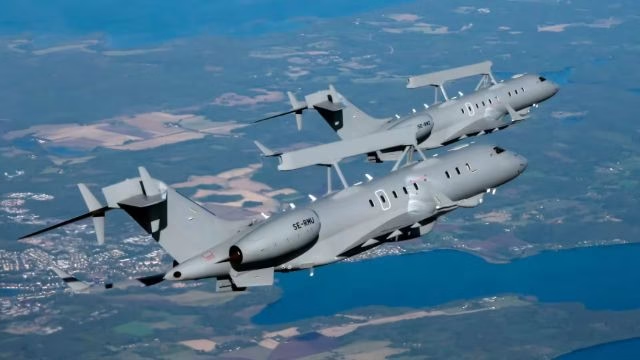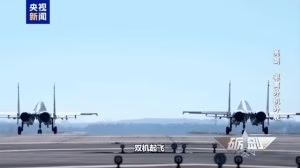France, Saab ink deal for GlobalEye AEW&C at Paris air show

At the Paris Air Show, a significant step forward in European defense collaboration took shape as Sweden’s Saab and France’s defense procurement agency, the Direction générale de l’armement [DGA], signed a joint declaration of intent to bring Saab’s advanced GlobalEye airborne early warning and control aircraft to the French Armed Forces.

The agreement, announced on June 18, 2025, signals France’s intent to acquire two GlobalEye aircraft, with an option to purchase two additional units, alongside ground equipment, training, and support.
While no formal contract has been finalized, the DGA indicated that negotiations are expected to conclude in the coming months, marking a potential milestone in France’s pursuit of enhanced situational awareness across air, land, and sea domains. This move underscores France’s strategic push to modernize its defense capabilities and maintain sovereignty over critical surveillance assets in an increasingly complex global security environment.
The GlobalEye, built on the Bombardier Global 6000 business jet platform, represents a cutting-edge solution in airborne surveillance. Its suite of active and passive sensors, centered around Saab’s Erieye Extended Range radar, enables long-range detection and identification of threats across multiple domains. Unlike traditional airborne early warning systems that focus primarily on air threats, the GlobalEye integrates maritime and land surveillance capabilities, offering a comprehensive picture of the battlespace.
With an endurance of over 11 hours and a range exceeding 6,000 miles, the aircraft can loiter over operational areas, feeding real-time data to air forces, navies, and armies. This multi-domain functionality aligns with modern military needs, where threats often span air, sea, and land simultaneously, from hypersonic missiles to stealthy submarines.
Saab’s President and CEO, Micael Johansson, emphasized the strategic value of the platform in a statement at the Paris Air Show: “We welcome today’s announcement by France about the intention to procure GlobalEye, which will enhance the French Armed Forces’ situational awareness and threat detection across the air, land and sea domains.
Our solution will enable France to maintain full sovereign control of its airborne early warning and control capability.” This focus on sovereignty resonates with France’s long-standing defense policy, which prioritizes independent control over critical military assets. The GlobalEye’s ability to integrate with existing French systems, such as the Rafale fighter jet and naval platforms, could provide a seamless upgrade to France’s current capabilities.
France’s interest in the GlobalEye comes at a time when its airborne early warning fleet, primarily composed of four Boeing E-3F Sentry aircraft, is aging. The E-3F, a variant of the U.S.-designed AWACS, has served as the backbone of France’s airborne surveillance since the 1990s, providing critical command-and-control support during operations in the Middle East, Africa, and Eastern Europe.
However, the platform’s radar and sensor systems, while upgraded over the years, struggle to keep pace with modern threats like low-observable aircraft and advanced missile systems. The GlobalEye, with its state-of-the-art Erieye radar, offers a significant leap forward, capable of detecting smaller radar cross-sections and tracking multiple targets at extended ranges, reportedly up to 350 miles for certain threats.
The Paris Air Show held biennially at Le Bourget, has long been a stage for major defense announcements, and this year’s event proved no exception. The Saab-DGA declaration reflects a broader trend of European nations investing in homegrown or regionally developed defense solutions to reduce reliance on U.S.-made systems.
Sweden, now a full NATO member since 2024, has positioned itself as a key player in this shift, with Saab’s portfolio of advanced systems, including the Gripen fighter and GlobalEye, gaining traction among allies. The choice of the Paris Air Show as the venue for this announcement carries symbolic weight, showcasing European defense collaboration at a time when geopolitical tensions, particularly in Eastern Europe and the Indo-Pacific, demand robust surveillance capabilities.
To understand the significance of France’s potential acquisition, it’s worth examining GlobalEye’s technical prowess in greater detail. The heart of the system is the Erieye Extended Range radar, a gallium nitride-based active electronically scanned array [AESA] radar mounted in a distinctive dorsal “ski box” above the aircraft’s fuselage.
This radar provides 360-degree coverage, with particular strength in detecting low-flying targets in cluttered environments, such as coastal regions or urban areas. Complementing the radar are electro-optical and infrared sensors, as well as maritime surveillance systems capable of tracking ships and submarines over vast ocean areas.
The GlobalEye’s data fusion capabilities allow it to integrate inputs from these sensors into a single, coherent operational picture, which can be shared with ground stations, ships, or other aircraft via secure data links.
Compared to other AEW&C platforms, the GlobalEye occupies a unique niche. The U.S. Navy’s E-2D Hawkeye, for instance, excels in carrier-based operations and air-centric surveillance but lacks the same level of maritime and land domain integration. Boeing’s E-7 Wedgetail, adopted by nations like the United Kingdom and Australia, offers robust air surveillance but is built on a larger, less fuel-efficient 737 platform.
The GlobalEye’s use of the Global 6000 airframe provides a balance of range, endurance, and efficiency, making it well-suited for nations with diverse operational needs. For France, which maintains global commitments from the Sahel to the South China Sea, this versatility could prove invaluable.
The historical context of France’s airborne surveillance capabilities sheds light on the strategic rationale behind this move. During the Cold War, France relied heavily on U.S.-provided systems like the E-3 Sentry to bolster its NATO commitments. While these platforms proved effective, they also tied France to American supply chains and maintenance schedules, limiting operational autonomy.
In recent decades, France has sought to diversify its defense portfolio, investing in European systems like the Airbus A400M transport aircraft and the Dassault Rafale. The potential acquisition of the GlobalEye fits this pattern, offering a European solution that aligns with France’s push for strategic independence while maintaining interoperability with NATO allies.
The Declaration of Intent also highlights the growing defense partnership between France and Sweden. Sweden’s accession to NATO in 2024, after decades of neutrality, has opened new avenues for collaboration with European allies. Saab, already a supplier of radar and missile systems to various nations, has benefited from this shift, with the GlobalEye previously ordered by the United Arab Emirates and Sweden itself.
The UAE’s deployment of the GlobalEye in regional operations, including maritime patrols in the Persian Gulf, provides a real-world example of the platform’s capabilities. France, with its extensive coastline and overseas territories, could leverage similar applications, particularly in monitoring contested maritime regions like the Mediterranean or the Indo-Pacific.
While the announcement marks a significant step, it’s not a done deal. The DGA’s statement that a contract is expected to be finalized in the coming months suggests a complex negotiation process lies ahead. Defense procurements of this scale often involve rigorous evaluations, budget approvals, and parliamentary oversight, particularly in France, where defense spending is closely scrutinized.
The inclusion of ground equipment, training, and support in the deal indicates a comprehensive package, but it also raises questions about costs and timelines. Large-scale defense projects, such as France’s H160M helicopter program, have faced delays due to budgetary constraints, and the GlobalEye acquisition could encounter similar challenges.
The option to purchase two additional aircraft adds flexibility but also uncertainty. Two GlobalEye units would provide France with a modest but capable AEW&C fleet, suitable for regional operations or limited deployments. However, expanding to four aircraft would enable more robust coverage, potentially allowing France to maintain continuous surveillance during high-tempo operations.
The decision to exercise this option will likely depend on operational needs, budget availability, and the performance of the initial aircraft. For now, the declaration of intent serves as a strong signal of France’s commitment to modernizing its airborne surveillance, but the path to operational deployment remains fraught with procedural hurdles.
The GlobalEye’s multi-domain capabilities could reshape how France approaches joint operations. In recent years, the French Armed Forces have emphasized interoperability across air, land, and sea units, particularly in coalition settings like NATO’s Enhanced Forward Presence in Eastern Europe or counter-piracy missions in the Gulf of Aden.
The GlobalEye’s ability to provide real-time data to multiple branches of the military could enhance France’s role as a leading NATO contributor. For example, during NATO’s 2023 Baltic Air Policing mission, AEW&C platforms played a critical role in tracking Russian aircraft near allied borders. A French-operated GlobalEye could similarly bolster situational awareness in contested regions, feeding data to Rafale jets or naval frigates.
Looking beyond France, the Saab-DGA agreement reflects broader trends in European defense. As nations like Germany, Spain, and the UK invest in next-generation systems, there’s a growing emphasis on collaborative platforms that enhance collective security. The Future Combat Air System [FCAS], a joint project between France, Germany, and Spain, aims to develop a sixth-generation fighter and supporting systems, including advanced sensors.
While the GlobalEye is not part of FCAS, its multi-domain capabilities align with the program’s focus on integrated warfare. Sweden’s involvement in such initiatives, through Saab’s expertise, could position it as a key partner in Europe’s evolving defense architecture.
The announcement also raises questions about the competitive landscape of AEW&C systems. While the GlobalEye offers unique advantages, it faces competition from established platforms like the E-7 Wedgetail, which the UK ordered in 2019 to replace its aging E-3D Sentry fleet.
The E-7, built on a Boeing 737-700 airframe, boasts a powerful MESA radar and has been battle-tested in Australian and U.S. operations. However, its larger size and higher operating costs may make it less appealing for nations seeking a more agile platform. The GlobalEye’s smaller footprint and multi-domain focus could give it an edge, particularly for nations with diverse operational requirements.
For the U.S. audience, the Saab-DGA deal offers a window into the shifting dynamics of global defense markets. While the U.S. remains a dominant supplier of AEW&C systems through platforms like the E-3 Sentry and E-2D Hawkeye, European solutions like the GlobalEye are gaining ground.
This trend reflects not only technological advancements but also a strategic pivot toward regional self-reliance. For American policymakers and defense planners, the rise of systems like the GlobalEye underscores the need for continued innovation to maintain a competitive edge in the global arms market.
As France moves toward finalizing this deal, the broader implications for NATO and European security remain in focus. The GlobalEye’s ability to enhance situational awareness could strengthen France’s contributions to collective defense, particularly in regions where rapid threat detection is critical.
Yet, questions linger about the procurement’s scope and timeline. Will two aircraft be sufficient to meet France’s operational demands, or will the option for additional units be exercised? How will budget constraints and competing priorities shape the deal’s outcome? These uncertainties, while typical in defense acquisitions, highlight the challenges of balancing ambition with practicality in an era of heightened global tensions.
***
Follow us everywhere and at any time. BulgarianMilitary.com has responsive design and you can open the page from any computer, mobile devices or web browsers. For more up-to-date news, follow our Google News, YouTube, Reddit, LinkedIn, and Twitter pages. Our standards: Manifesto & ethical principles.
















